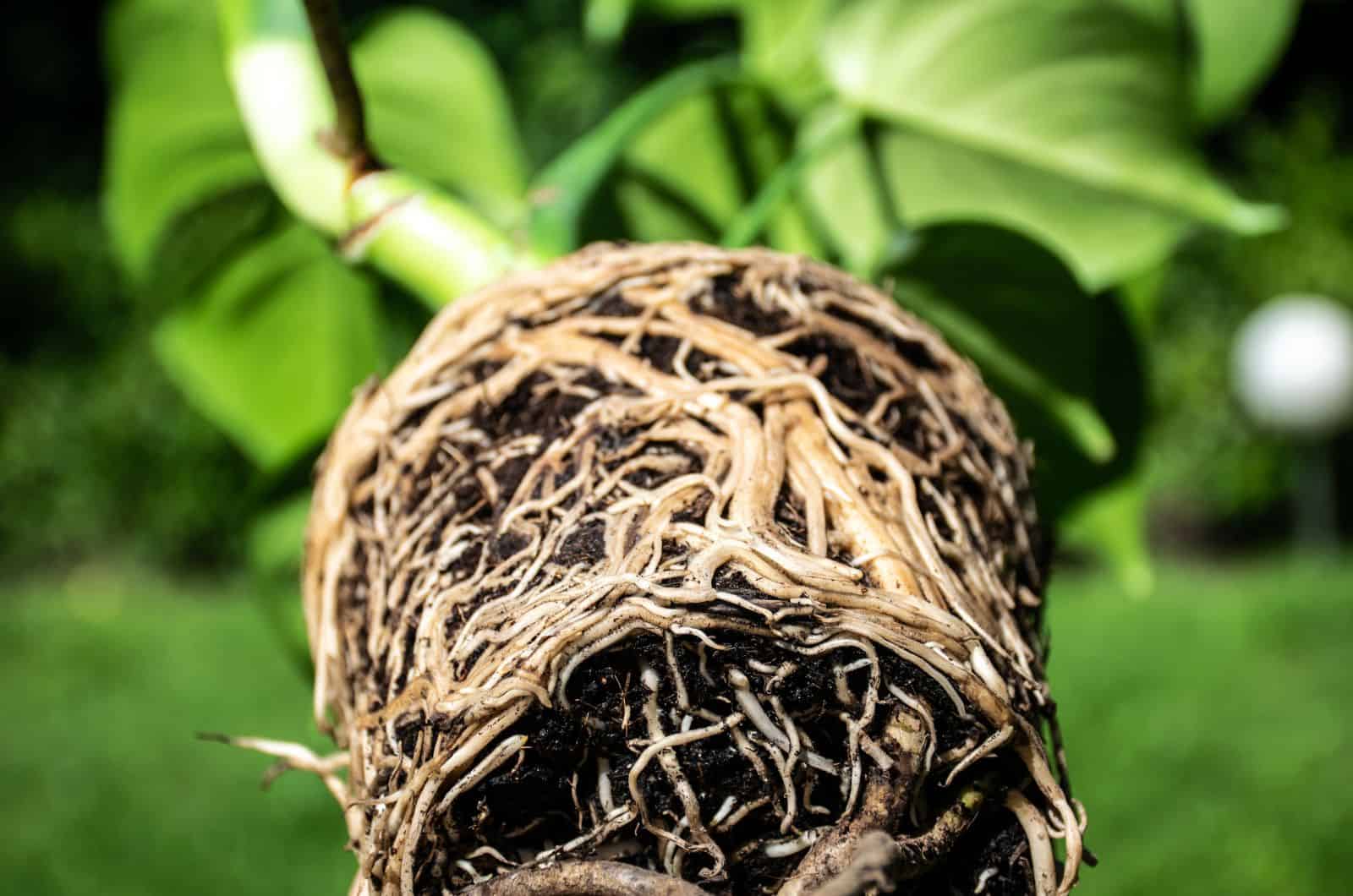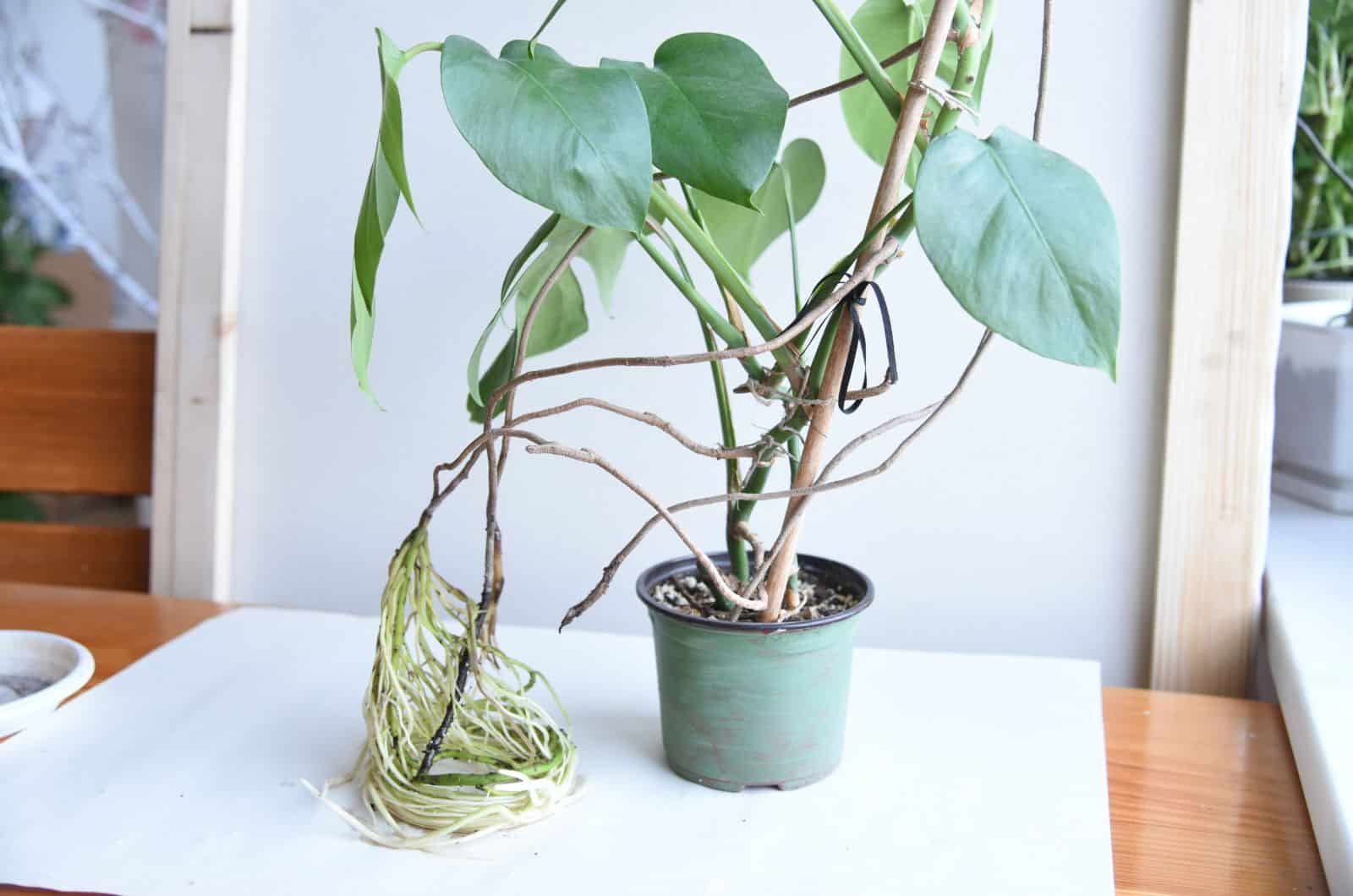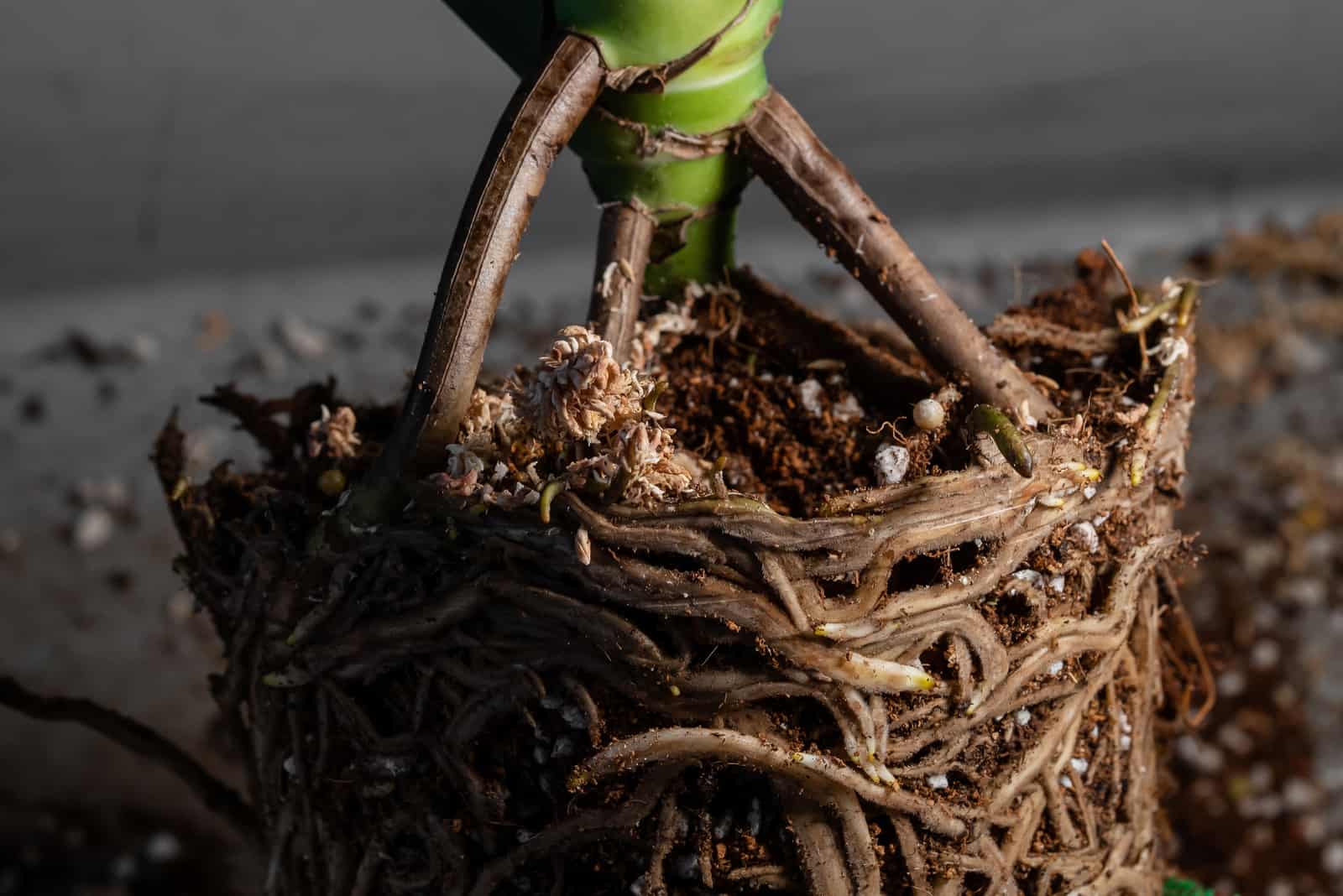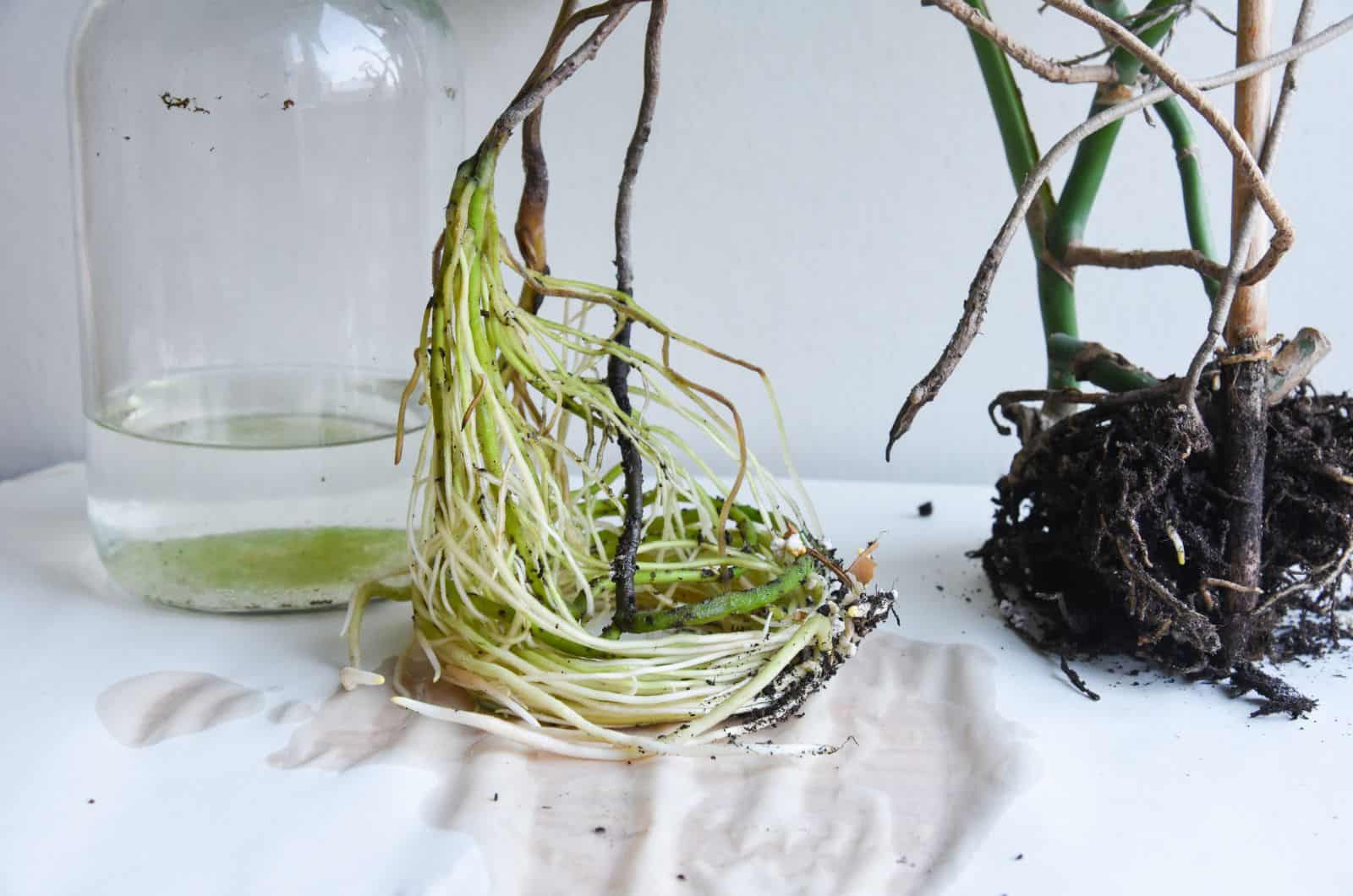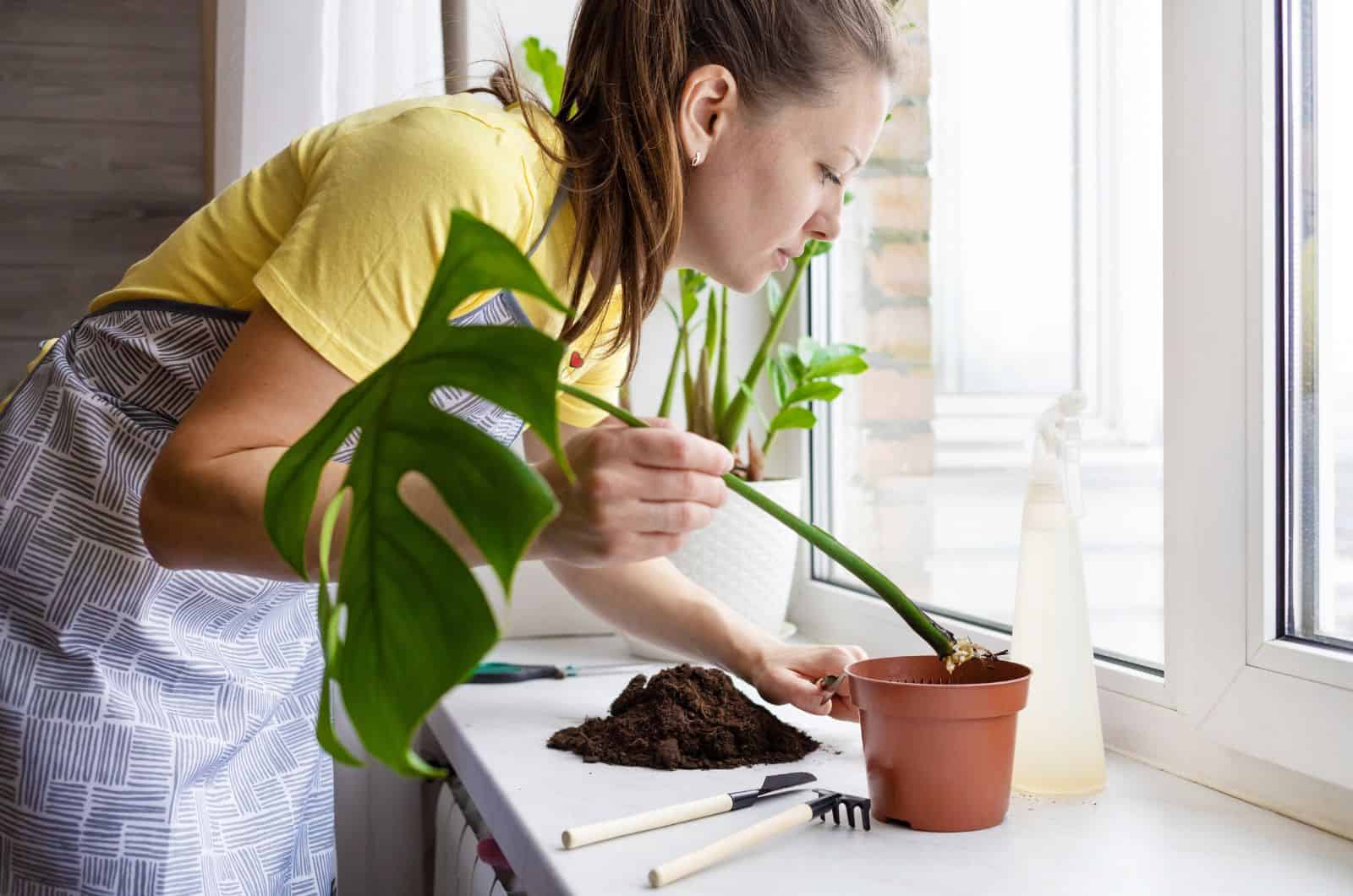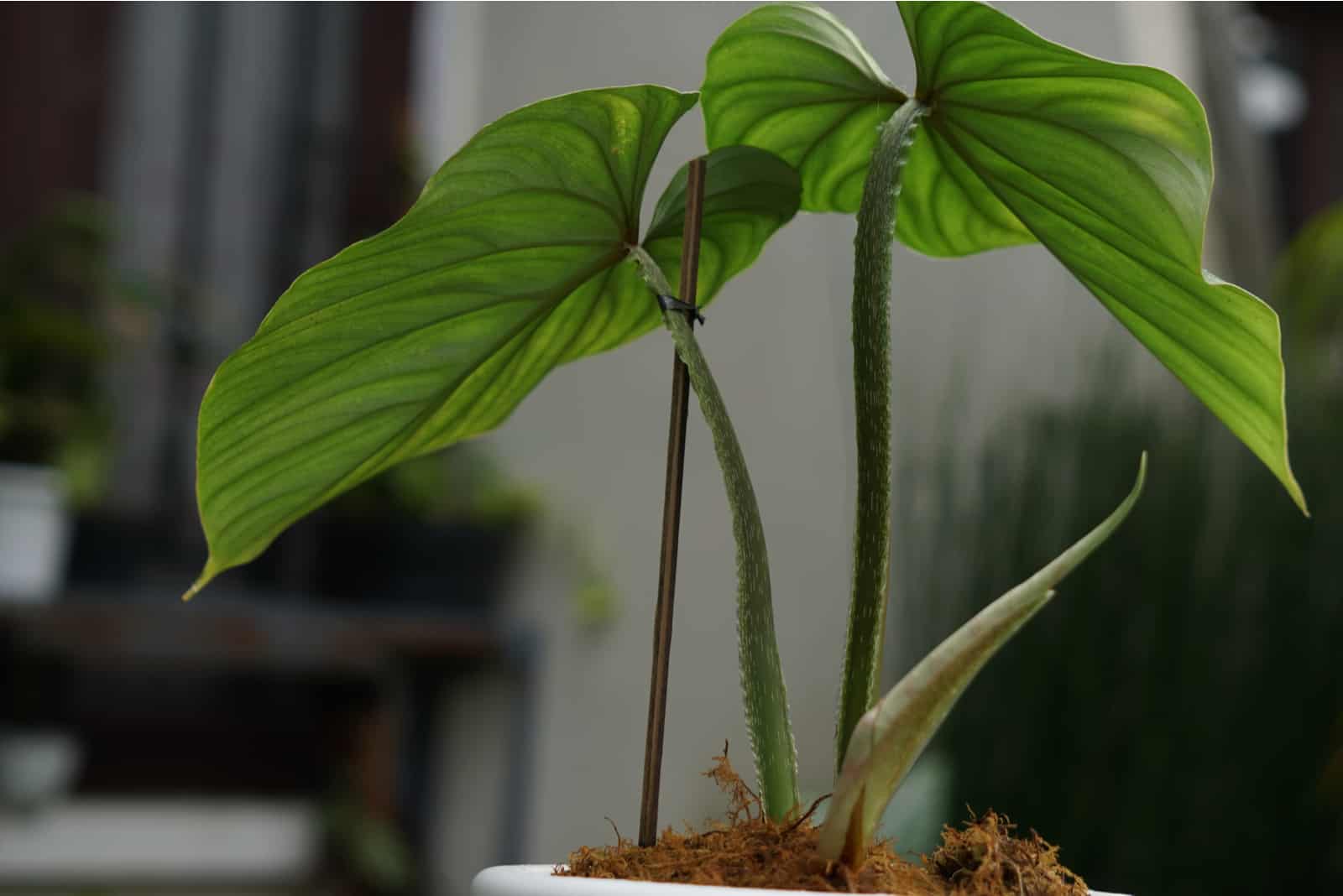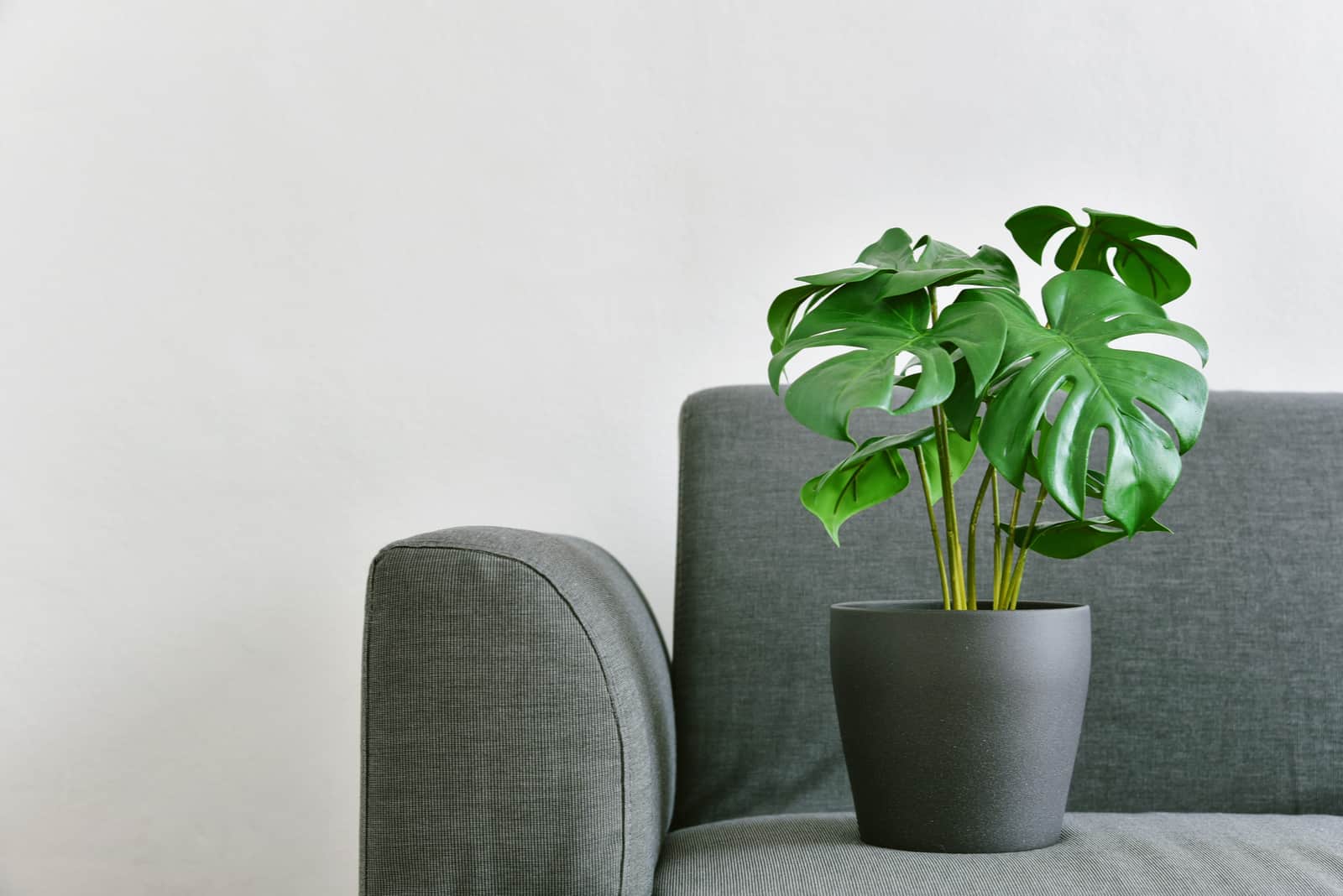Monstera is an attractive and popular plant, and it has three different types of roots.
This is important because all the types of monstera roots have different functions, and we’re going to learn more about them in the sections below.
The most interesting roots are definitely the aerial roots, and we’ll pay close attention to them by providing care tips, a repotting guide, and much more!
Before we discuss these issues, let’s learn more about monsteras:
[table id=277 /]
Let’s get started.
The 3 Types Of Monstera Roots
There are many popular monsteras with green or variegated foliage, and they are all easy to care for – the care guide of monstera marmorata proves it.
However, they all have three types of roots, all of which play a role in the plant’s growth and development.
We’re going to examine these roots and discuss their respective functions and importance to the plant’s overall health.
Aerial Roots
Climbing plants have aerial roots, and the monstera is no exception. Depending on the plant variety, these roots grow above the ground and have different functions.
They start at the node and at first resemble small lumps inhabiting the monstera stems. But as they develop, they get more elongated and can reach a couple of feet long.
Aerial roots serve as an anchor to support the plant and allow it to grow upwards while leaning on a tree (or stake in the case of indoor plants). They also absorb air moisture and increase plant hydration.
Certain plant varieties, such as spider plants, develop aerial roots that can be propagated. They resemble tiny clones of the bigger plant, and you can just cut and replant them in a new pot to get more of them.
However, some plants, like mistletoe, have parasitic aerial roots that bore into their roots and suck out all the nutrients, breaking and destroying the tree.
What about monstera aerial roots? How do they work for these plants?
Let’s find out!
Why Do Monsteras Have Aerial Roots?
The primary function of monstera aerial roots is support. These plants need something to attach themselves to tall trees so they can get to the source of light.
Monsteras’ natural habitats are dense rainforests that don’t let in enough sunlight, so certain varieties (monsteras included) have developed the ability to anchor themselves to taller plants and grow on them in search of light.
But that is not the only function of these above-ground roots. Monstera aerial roots also absorb moisture from the air around them to moisturize your plant.
These roots are not the primary source of water for your plants, and you must always irrigate your plant whenever the topsoil dries out.
Aerial-Subterranean Roots
Aerial-subterranean roots are a combination of aerial and underground roots. They start developing as aerial roots but then grow into the soil.
Their purpose is also a mix of aerial and lateral-subterranean roots, which means they support the monstera plant during its continuous growth.
They can also act as lateral-subterranean roots and absorb the moisture and nutrients the plants need for proper growth.
Lateral-Subterranean Roots
Lateral-subterranean roots are the roots found underground. Their purpose is to support the entire plant, absorb nutrients, and uptake water from the soil.
All plants except air plants have root systems like these.
They are frequently referred to as lateral-subterranean roots for two reasons. First of all, they grow and spread below the ground level, hence the term “subterranean.”
They also spread out laterally (sideways) from the primary root that expands from the stem.
What To Do With Aerial Roots
The monstera is a perfect houseplant for beginners because it doesn’t require too much care, but you shouldn’t completely neglect it.
This refers to the aerial roots as well!
In the sections below, you will learn more about how to help your plant’s aerial roots grow big, strong, and beautiful.
Training The Monstera On A Trellis
Training a monstera has its perks, and the most obvious one is that it gives your epiphyte a cleaner look. For instance, a Swiss cheese plant that develops brown, woody aerial roots is unattractive, but staking it can help with this issue.
These plants are natural climbers, so they constantly find ways to elongate and grow upwards. Therefore, you should get your monstera to climb a moss pole or some other alternative to help it develop healthily and reduce the mess that long, stringy roots can make.
Staking these plants is relatively easy – simply tie the thick, mature stems of your plant to the pole, and the aerial roots will attach themselves to it.
Getting your monstera deliciosa (or any other vining plant) to climb can promote faster growth and more foliage to adorn your home.
However, you should keep in mind the growing conditions and moisture of the moss pole. Mist the stake from time to time or find some other ways to keep the moss pole moist.
Guide The Roots Into The Soil
Monstera care doesn’t strictly demand trellising, so you can leave the roots as they are if you choose. However, this option can lead to a wild and untamed look in mature plants, so you may need to find other ways of attaining a cleaner appearance.
One way to tame monsteras is by directing their roots into the soil. The roots spreading around is a sign that your plant is healthy, but as it can sometimes give off too wild a vibe, some growers decide to tuck them into the soil.
Of course, this method has a downside. Aerial-subterranean roots will continue to develop, which can make repotting harder.
Pruning Aerial Roots
Getting a new plant is one of the best feelings in the world, although caring for it can be too much sometimes.
For instance, the variegated monstera is an amazing choice for any home, but it will require some extra care if you decide not to stake it.
Aerial roots can be unsightly, so you should either train your plant on a moss pole (or any other stake), direct it to grow into the soil, or prune them.
You can trim the roots with some sharp shears, just don’t get too close to the stem as you could cut and damage it, which creates a doorway for all sorts of pests, bacteria, and fungi to enter.
However, you should know that they will grow back, so be prepared for a lot of pruning. You can reduce the time necessary for aerial root growth by removing them at the end of the growing season, or at least in mid-to-late summer.
Secateurs for arthritic hands can help you here as they have ergonomic handles and reduce the pressure you have to make on the shears to make them cut.
Finally, ensure that the pruners are always sterilized to prevent the spread of bacteria and fungi onto healthy plants.
How To Promote Aerial Root Development
One of the best ways to encourage more aerial roots on your monstera is proper plant care.
Some of the key things to pay attention to are lighting, watering and humidity, temperature, potting soil, and additional feeding.
Monstera Care Overview
This plant doesn’t require too much sunlight, but 5-8 hours of indirect light is necessary for proper growth. Your monstera can also grow in somewhat low-light conditions, but their growth will be stunted, and they might get leggy and lose some of their beautiful colors.
If you have just gotten a new monstera, remember to water it 2-4 times a month. Overwatering shouldn’t be taken lightly as it can lead to root rot, which is why you should avoid it at all costs. However, an underwatered monstera can also lead to many issues as your plant is deprived of the moisture and nutrients it needs for healthy growth.
Monsteras are native to tropical climates, so they need high humidity for optimal development. You can mist them occasionally or invest in a humidifier to keep them hydrated.
These plants prefer mild temperatures between 68–86°F, which is why they are perfect for indoors, where you can control the conditions.
The growing medium should be fertile and well-draining, so you can enrich it with ingredients such as humus, peat moss, perlite, bark, etc.
Finally, don’t forget to fertilize your monstera plant, or else the new growth will take much longer to appear. Use fertilizers with a ratio of 3:2:1, such as 3-2-1, 6-2-3, 12-4-8, etc., as they contain enough nitrogen for vegetative growth and proper development of monstera leaves.
Fertilize this plant during its growing season and follow the instructions on the back of the packaging.
Can Mature Aerial Roots Dry Out?
Mature aerial roots usually look brown and woody, so it’s easy to mistakenly believe that they have dried out due to negligence.
However, that’s perfectly normal, and if you provide enough water and air moisture to your plant, it won’t need additional hydration to the aerial roots.
Some owners dip these roots in water to encourage faster growth and more new leaves, but this isn’t strictly necessary. Aerial roots can absorb some moisture when put in water, but their primary function is attaching to other plants (or poles and stakes), not uptaking water.
You don’t have to mist aerial roots if the air around your plant is humid enough. However, you can spray the roots if you grow them on moss poles, as that will keep the stake moist and your plant hydrated.
Can You Use Aerial Roots For Propagation?
Unfortunately, propagating monstera without the node is simply not possible, and because monstera aerial roots don’t have any nodes, they cannot be used for propagation.
However, you can multiply these plants by cuttings, seeds, division, and air layering – you just have to find the method that suits you best.
Repotting A Monstera With Aerial Roots
The Monstera has an underground root system that doesn’t grow very fast, but your plant can still become root bound if you don’t repot it frequently enough.
Pot-bound plants might not seem like much of an issue at first, but their growth will slow down and become stunted, and they can start wilting because of nutrient deficiency.
Therefore, you should repot your monstera plants every 1-2 years in an aroid soil blend. You can also create your own potting mix.
Repotting A Monstera With A Moss Pole
The first step is taking the monstera out of its current container. I prefer doing this with a friend who can support the plant while I take it out of the pot.
You can also spread out some old blankets to make your plant comfortable, just be sure that the roots, leaves, and stems don’t get all squashed during the process.
Use a trowel or some other tool to get the root ball out of the pot, then gently work your way around the pot walls.
Whatever you do, never pull the base of your plant or the pole, as that can only cause damage!
When repotting a monstera with a moss pole, you should keep it all together when replanting and carefully put the roots and stake into the new container.
Support the pole with your hand until you completely fill the pot with new soil.
Repotting A Monstera Without A Moss Pole
Transplanting a monstera without a trellis or pole might seem tricky, but it can be done with a little bit of effort.
You can wrap the plant in a tarp or sheet to gain more control before you start removing it from the pot. Again, carefully tip the container to one side and gently take the monstera out of it.
Fill the new pot with fresh soil, place the monstera in it, and add more growing medium, taking care to fill the empty spaces. Just lift the sides of the plant and add soil to the sides until you fill the pot.
This method can damage some roots and stems, but you can just prune those away. Of course, you should be careful not to damage too many stems as this can adversely affect your plant’s health.
As the plant gets bigger, it becomes more difficult to transplant it without the trellis, so make sure you have someone to help you or stake it on a pole to make it more manageable.
Monstera Plants In The Wild And Indoors
There are some fundamental differences between monsteras nurtured indoors and those that grow in their natural habitat.
Different conditions affect the plant’s roots as well, so we’ll now examine the differences between monsteras in the wild and indoors.
Monstera Plants In The Wild
One of the main differences between a wild and indoor-grown monstera is the size. When grown in the wild, a monstera can reach a height of about 60 feet tall and even produce edible, corn-like fruit.
The monstera’s behavior in the wild gives us an insight into its growth habits and the reason it develops in a certain way.
The rainforest bed doesn’t get enough sunlight, which isn’t that big of a deal for monstera seedlings. Young monstera plants demonstrate a unique feature called skototropism, which means that they grow towards the dark area and not the light.
This feature is incredibly important because it lets young plants seek out the tree trunk, attach to it thanks to their aerial roots, and then start growing on it.
Older plants require a certain amount of sunlight, which is why they climb high up the tree and even develop fenestrations through which the light can shine towards lower leaves.
Monstera Plants Grown Indoors
Indoor monsteras develop in the same way as those that grow in the wild, but they don’t usually get as tall or produce flowers and fruit.
They do develop aerial roots, so we can stake them to mimic the conditions in their natural habitat.
The roots of indoor monstera plants are smaller than the roots of wild plants simply because the indoor plants are much smaller.
We tend to give our plants whatever they want, so they don’t have to grow really tall in order to get sunlight, and they don’t have to spread their roots deep and wide in order to search for water and nutrients if the soil is less fertile and moist.
The fact that monstera seedlings grow towards the dark to search for the tree trunk explains why they can be grown in low-light conditions and then moved to a brighter spot once they get older.
Other Plants With Aerial Roots
Monsteras aren’t the only plants that develop aerial roots. A wide range of pothos, philodendrons, phalaenopsis orchid, and ficus also grow on other trees or moss poles and trellises in the case of indoor plants.
Therefore, your monstera adansonii varieties or monstera deliciosa won’t feel too lonely in a new indoor jungle!
Pothos is an excellent addition to any design (especially one mimicking the rainforest) as you can grow them in hanging pots and use them to complete the decor of any room.
Common Questions
There are more questions about monstera roots and monsteras in general that still need to be answered.
We picked a few of the most frequently asked ones and will look into them more closely in the sections below.
Let’s begin!
What is the lifespan of a monstera?
Monsteras are perennial plants that can live up to 40 years in the right conditions.
However, if the circumstances aren’t ideal, monsteras trigger their defense mechanisms and go dormant until the situation improves.
This allows the plant to weather the bad conditions and save its energy.
Of course, this plant won’t live forever, but 40 years is still a long time – and you can even take some cuttings and propagate it before it starts losing its leaves and dies.
How can you tell if monstera roots are healthy?
Healthy aerial roots are white, green, or brown, and they get darker as they grow old and become more and more woody.
Firm, strong roots and the overall healthy appearance of the plant are common signs that there’s nothing wrong with the roots.
However, detecting and diagnosing root rot for certain can be a little problematic as you can’t see the roots directly.
Yellowing and soft leaves, black or brown spots, and stunted growth can all indicate root disease, but also some other issues such as nutrient deficiency, sunburns, etc.
Therefore, you should take the plant out of its container and examine the underground roots. If they are mushy and black or brown, you should remove them, treat the rest of the roots with a fungicide, and repot the plant into a new container filled with fresh soil.
Final Word
This article contained everything you need to know about monstera roots! There are three types of roots in monstera plants that all serve different functions and help them develop on all fronts.
Aerial roots support it while it climbs other plants or moss poles, while aerial-subterranean roots are just aerial roots that start growing into the ground instead of attaching to other plants.
Lateral-subterranean roots support the entire plant and absorb the nutrients and water the plant needs.
Aerial roots are probably the most interesting ones so we described them in more detail.
We provided some tips and tricks for taking care of and using them, promoting their development, and repotting the monstera plants that have them.
Finally, we included some other plants that develop aerial roots to keep your monstera company and accentuate the beauty of your home.
Enjoy your climbing monsteras, and until next time!
Like this post? Share or pin it for later!

